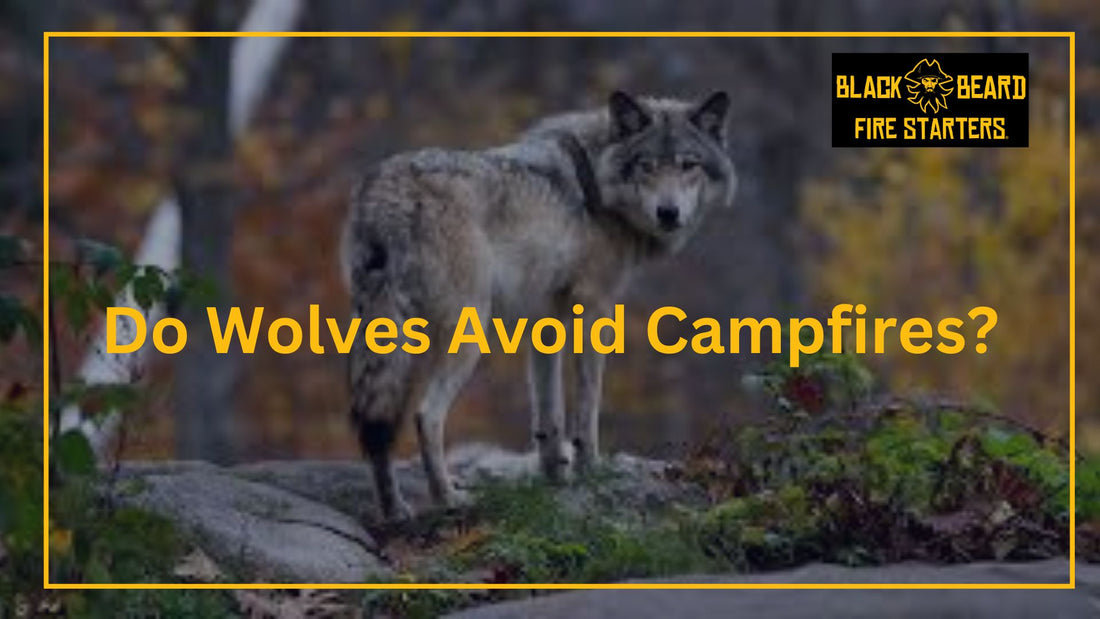The question of whether wolves avoid campfires is a topic that has intrigued campers and wildlife enthusiasts for years. While tales of wolves shying away from the light and warmth of a crackling fire have been passed down through generations, the scientific validity of this belief remains uncertain. Understanding the behavior and instincts of these majestic creatures in the presence of such human-made elements opens a window into the complex interactions between wildlife and our shared environments. As we explore the nuances of wolf behavior and their reactions to campfires, we may uncover insights that challenge common assumptions and shed light on the subtle dynamics of coexistence in the wilderness.
Key Takeaways
- Wolves may not inherently avoid campfires, as their behavior is influenced by various factors.
- Campfire tales perpetuate the myth of wolves avoiding fires, rooted in cultural beliefs and storytelling traditions.
- Understanding wolf behavior, sensory perception, and ecological dynamics is crucial for campers.
- Wolves' responses to campfires depend on their environment, instincts, and the specific circumstances at hand.

Origins of the Myth
The myth surrounding wolves avoiding campfires likely originated from early human observations of wolves exhibiting cautious behavior towards unnatural sources of light and heat. In various cultural beliefs and historical contexts, wolves have been depicted in urban legends, mythological roots, and folklore traditions as creatures wary of human presence and activities. This superstition has deep storytelling traditions and ancient beliefs, portraying wolves as mystical and cunning beings that shun man-made fires. Mythological creatures like werewolves also contribute to the perpetuation of this belief. Through centuries of storytelling and cultural exchange, the notion of wolves avoiding campfires has become ingrained in the collective consciousness, blending reality with myth to create a compelling narrative.
Folklore and Campfire Tales
Exploring the rich tapestry of folklore and campfire tales reveals a myriad of intriguing narratives woven into the fabric of cultural storytelling. Folklore traditions across the globe are rich with stories of supernatural creatures, ghost stories, urban legends, and mythical beings that have been passed down through generations. Campfire rituals have long served as the backdrop for sharing spooky tales of haunted forests, creepy legends, and scary folklore. These stories often serve as cautionary tales or ways to explain the unexplained, captivating listeners with their eerie details and captivating twists. The art of storytelling around a campfire continues to be a cherished tradition, allowing communities to bond over shared experiences and keep alive the mystique of the unknown.
Wolf Behavior Patterns
Folklore and campfire tales often depict wolves as mysterious and cunning creatures, but understanding their behavior patterns in the wild provides valuable insights into their true nature. Wolves exhibit intricate pack dynamics, where a dominant alpha pair leads the group in hunting strategies and maintaining territorial boundaries. Communication methods such as howling, body language, and scent marking play crucial roles in coordinating pack activities and signaling danger. Mating rituals are elaborate, with only the alpha pair typically reproducing, reinforcing social hierarchies. Prey selection is strategic, influenced by the pack's size and the availability of food sources. Denning habits, survival instincts, and environmental adaptations further showcase the resilience and adaptability of these majestic creatures in their natural habitats.
Sensory Perception of Wolves
Enhancing our understanding of wolves involves delving into their intricate sensory perception mechanisms, which play a crucial role in their survival and interactions within the pack.
- Wolf Senses: Wolves have keen senses, including acute hearing and a strong sense of smell.
- Prey Detection: Their sensory abilities aid in detecting prey over vast distances in various terrains.
- Survival Instincts: These senses are vital for survival, helping wolves navigate their environment and avoid potential threats.
- Hunting Strategies: Wolves use their senses to coordinate hunting strategies within the pack efficiently.
-
Social Communication: Sensory perception also facilitates social communication, reinforcing pack dynamics and maintaining territorial boundaries.

Campfires Vs. Natural Predators
Amidst the wilderness, the contrast between campfires and the natural predators that roam the landscape raises intriguing questions about the interactions between humans and wildlife. Predator-prey dynamics play a crucial role in understanding how natural predators respond to the presence of campfires near their habitats. Fire ecology studies show that certain predators may be attracted to campfires due to the potential for scavenging opportunities or warmth. However, other species may avoid the light and noise associated with campfires, relying on their survival instincts to steer clear of human activity. Nighttime behaviors of predators can vary significantly, affecting their ecological interactions with humans. To mitigate human-animal conflicts, campers should consider campsite precautions and understand wildlife responses, including behavioral adaptations and natural defenses.
Scientific Studies and Findings
Predator responses to campfires have been the subject of various scientific studies, shedding light on the behaviors and tendencies of wildlife in proximity to human activities.
- Predatory instincts: Wolves showcase a mix of curiosity and wariness towards campfires.
- Behavioral responses: They exhibit cautious approaches, often circling downwind to assess the situation.
- Habitat preferences: Wolves tend to avoid heavily human-populated areas with frequent campfire use.
- Survival strategies: Their avoidance can be linked to minimizing potential risks and conserving energy.
- Environmental factors: Factors like wind direction and noise levels near campsites influence their decision-making process.
These studies emphasize the complex interplay of predatory instincts, environmental factors, and survival strategies in shaping wolves' responses to campfires.
Human-Wolf Encounters
Human encounters with wolves in the wild often present unique opportunities for observing interspecies interactions and understanding the dynamics of coexistence in shared environments. Wolf communication, through howling and body language, plays a crucial role in pack dynamics and maintaining social bonds. Observing hunting strategies offers insights into their coordinated efforts and efficient prey selection. Territorial boundaries are marked through scent marking, crucial for avoiding conflicts and mating rituals. Understanding den locations provides valuable information on their reproductive behaviors. Human-wolf encounters can also lead to human-wildlife conflicts, especially in cases of habitat fragmentation. By studying these interactions, we gain a better understanding of wolves' behavior and how to mitigate conflicts to foster coexistence in shared ecosystems.
The Role of Fire in Nature
Within natural ecosystems, fire plays a critical role in shaping landscapes and influencing ecological processes. Fire ecology studies reveal its significance in promoting biodiversity, habitat modification, and ecosystem resilience. Ecological impacts of fire extend beyond physical alterations to the environment, influencing predator-prey dynamics and wildlife interactions. Behavioral responses to fire, such as adaptation and avoidance, are crucial for species survival. Effective fire management strategies are essential for balancing conservation efforts and human safety. Biodiversity conservation efforts increasingly recognize the importance of controlled burns and natural fire regimes in maintaining healthy ecosystems. Understanding the multifaceted role of fire in nature is key to promoting sustainable coexistence between humans and wildlife.
Evolutionary Perspectives
From an evolutionary standpoint, the interplay between fire and wildlife has shaped behavioral adaptations and ecological dynamics. Wolves, as social predators, exhibit intricate survival instincts and pack dynamics influenced by their environmental adaptation. Through natural selection, wolves have developed genetic predispositions for prey detection and predator avoidance, essential for their survival within their territorial boundaries. The social hierarchy within wolf packs plays a crucial role in ensuring efficient predator avoidance and maximizing hunting success. Behavioral conditioning further reinforces these adaptations, contributing to the overall resilience of the species. Understanding these evolutionary perspectives provides valuable insights into the complex interactions between wolves and their environment, highlighting the intricate balance between instinctual behaviors and learned responses.
Wildlife Management Strategies
Effective wildlife management strategies rely on a comprehensive understanding of ecological dynamics and species behavior. To protect wildlife and maintain ecosystem balance, various strategies are employed, including:
- Wildlife tracking: Monitoring animal movements and populations to inform conservation decisions.
- Habitat restoration: Rehabilitating degraded habitats to provide suitable living conditions for wildlife.
- Predator-prey dynamics: Studying interactions between predators and prey to ensure a balanced ecosystem.
- Conservation efforts: Implementing measures to safeguard endangered species and their habitats.
-
Environmental education: Educating the public about the importance of wildlife protection and sustainable practices.

Safety Tips for Campers
Ensuring camper safety in the wilderness requires a thorough understanding of potential risks and the implementation of appropriate precautionary measures. When venturing into the wild, campers should be aware of the risks associated with bear encounters, poisonous plants, and changing weather conditions. It is essential to possess wilderness survival skills, knowledge of emergency first aid, and proficiency in navigation to navigate safely. Proper campsite setup, including food storage to prevent wildlife encounters, is crucial. Additionally, being able to track wildlife and interpret weather forecasts can enhance safety. Campers should prioritize fire safety by following guidelines for building, maintaining, and extinguishing fires responsibly. By incorporating these safety tips, campers can enjoy a safer and more secure outdoor experience.
Myth Busted or Confirmed?
The interaction between wolves and campfires has long been a subject of curiosity and speculation among outdoor enthusiasts and wildlife researchers alike. In debunking the myth, it is essential to consider various factors that influence wolf behavior around campfires.
- Animal Instincts: Wolves rely on their instincts to navigate their surroundings.
- Survival Instincts: Survival is a primary driving force behind wolf behavior.
- Predatory Behavior: Wolves' natural hunting instincts may influence their response to human presence.
- Human Presence: The presence of humans can evoke different responses from wolves.
- Fear Response: Wolves may exhibit fear responses in unfamiliar or threatening situations.
Understanding these aspects can shed light on the nighttime behavior of wolves, their perception of fire, and how they interact with wildlife in their natural habitats.
Conclusion
In conclusion, the myth that wolves avoid campfires is not supported by scientific evidence. Wolves are known to be curious and intelligent creatures, and their behavior is influenced by various factors such as food availability and social dynamics. Campfires may temporarily deter wolves due to the bright light and unfamiliar scent, but they are not a foolproof method of deterring natural predators. Understanding wolf behavior and implementing proper wildlife management strategies are crucial for coexisting safely with these magnificent animals in their natural habitats.

